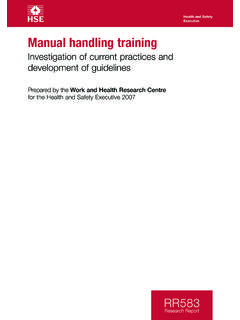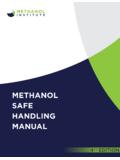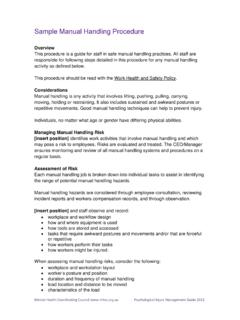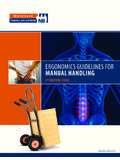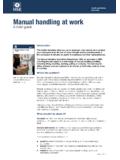Transcription of TRAINING MANUAL - Home | Food and Agriculture …
1 54 Report of the Fifth Meeting of the Governing CouncilTRAINING MANUAL onthe construction ofFRP beach landing boatsbyJohn McVeaghFAO ConsultantThomas AnmarkrudFAO Consultant yvind GulbrandsenFAO ConsultantRevanoor RavikumarRegional Project CoordinatorPer DanielssonGlobal Project CoordinatorandAri GudmundssonFishery Industry Officer (Vessels)Fishing Operations and Technology ServiceFisheries and Aquaculture Resources and Conservation DivisionFAO, RomeGCP/GLO/200/MUL2 TRAINING MANUAL on the construction of FRP beach landing boatsThis TRAINING MANUAL is one of a series prepared during the course of the projectGCP/GLO/200/MUL. The conclusions and recommendations given in the documentare those considered appropriate at the time of its preparation. They may be modifiedin the light of further knowledge gained at subsequent stages of the designations employed and the presentation of material in this publication do notimply the expression of any opinion whatsoever on the part of the Food and AgricultureOrganization of the United Nations (FAO) concerning the legal or development statusof any country, territory, city or area or of its authorities, or concerning the delimitationof its frontiers or boundaries.
2 The mention of specific companies or products ofmanufacturers, whether or not these have been patented, does not imply that thesehave been endorsed or recommended by FAO in preference to others of similar naturethat are not views expressed in this publication are those of the authors and do not necessarilyreflect the views of rights reserved. Reproduction and dissemination of material in this publication foreducational or other non-commercial purposes are authorized without any prior writtenpermission from the copyright holders provided the source is fully of material in this publication for resale or other commercial purposes isprohibited without written permission of the copyright holders. Applications for suchpermission should be addressed to: Chief, Electronic Publishing Policy and SupportBranch, Communication Division, FAO, Viale delle Terme di Caracalla, 00153 Rome,Italy, or by e-mail to: FAO 2010 Cover photo:The first FRP IND-30 design beach landing boat under construction during the TRAINING course at Ayyappa BoatBuilders in Kakinada, Andhra Pradesh, India, under the FAO project Safety at sea for small-scale fisheries indeveloping countries (GCP/GLO/200/MUL), funded by the Swedish International Development Cooperation Agency(Sida), the International Maritime Organization (IMO) and the Swedish Maritime Administration (SMA).
3 3 TRAINING MANUAL on the construction of FRP beach landing boatsPreparation of this documentThis MANUAL has been developed from information collected during the FAO project Safety at sea for small-scale fisheries in developing countries (GCP/GLO/200/MUL),funded by the Swedish International Development Cooperation Agency (Sida), theInternational Maritime Organization (IMO) and the Swedish Maritime Administration(SMA).The MANUAL was partly developed from the FAO Fisheries and Aquaculture TechnicalPaper 507: Fishing boat construction: 4. Building an undecked fibreglass reinforcedplastic boat, by Thomas Anmarkrud. It draws heavily from the experience gained duringa TRAINING course conducted in Kakinada, India for FRP boatbuilders and from currentpractices in India and Sri Lanka in building beach landing fishing boats of the FAO IND-30 design were built during the TRAINING course.
4 YvindGulbrandsen, FAO Consultant Naval Architect, was responsible for the final MANUAL on the construction of FRP beach landing boats4 TRAINING MANUAL on the construction of FRP beach landing boatsAbstractThis MANUAL on construction of fibreglass reinforced plastic (FRP) beach landingboats has been prepared primarily to assist small boatyards in Tamil Nadu,India that build beach landing fishing boats, but may also be used as a guide formaking good quality FRP boats as well as for FRP TRAINING in the MANUAL should be seen as a supplement to FRP boatbuilding manualsavailable in the Food and Agriculture Organization of the United Nations (FAO)and other international publications. It assumes prior knowledge of FRP handlay-up processes and terms generally used in the on working conditions, materials and quality control are basedon tropical ambient conditions and the type of boatyards likely to build I of the MANUAL contains general information on FRP materials, handlingand working conditions.
5 Part II describes the building of a hull plug and a mouldand Part III describes the building of a beach landing boat. Finally, Part IV containsinformation on manufacturing defects and MANUAL has four annexes that provide further information related to FRPboatbuilding. Annexes 1 and 2 contain a bibliography and a glossary, drawings for the FAO IND-30 boat design are provided in Annex 3. Finally,Annex 4 contains the draft recommended construction standards for FRPfishing vessels. These standards are a part of the FAO/ILO/IMO Safetyrecommendations for decked fishing vessels of less than 12 m in length andundecked fishing vessels, which are currently under MANUAL on the construction of FRP beach landing 9 Part I - General Information1 Fibreglass Reinforced Plastic .. 132 Material Description and Handling.
6 133 Workshop 184 Tools to be Used .. 195 Basic Laminate Building .. 226 Quality .. 257 Health and Safety Issues .. 26 Part II - Building and Plugs and Moulds8 Making the Hull Plug .. 329 Making the Mould .. 38 Part III - Building an FRP Beach Landing Boat10 Building an FRP Beach Landing 42 Part IV - Manufacturing Defects and Repairs11 Manufacturing Defects .. 6412 Repairs .. 65 Annex 1 - 73 Annex 2 - 74 Annex 3 - Drawings .. 77 Annex 4 - FRP Construction 127 Appendix 1 - Illustration of Terms used in the Definitions .. 128 Appendix 2 - Recommended Construction Standards for GRP Fishing Vessels .. 1315 TRAINING MANUAL on the construction of FRP beach landing boats6 TRAINING MANUAL on the construction of FRP beach landing boatsAcronymsBLCB each landing craftBOBP-IGOBay of Bengal Programme Inter-Governmental OrganisationCIFNETC entral Institute of Fisheries Nautical and Engineering TrainingCSMC hopped strand matFAOFood and Agriculture Organization of the United NationsFRPF ibreglass reinforced plasticILOI nternational Labour OrganizationIMOI nternational Maritime OrganizationMEKPM ethyl ethyl ketone peroxideMEKM ethyl ethyl ketonePVAP olyvinyl alcoholPVCP olyvinyl chlorideSidaSwedish International Development Cooperation AgencyWRWoven roving7 TRAINING MANUAL on the construction of FRP beach landing boatsAcknowledgementsThe authors gratefully acknowledge the important contributions of many expertswith fiberglass
7 Reinforced plastic (FRP) boatbuilding experience, includingV Babu Rao, National FRP Consultant, for his excellent support during thetraining and boatbuilding exercise in Kakinada, Andhra Pradesh, India, as wellas Ayyappa Boat Builders for providing the thanks are also due to BOBP-IGO and its Director, Dr Yugraj SinghYadava, for their excellent logistic support to the FRP boatbuilding trainingcourses in obtaining trainee nominations from the Department of Fisheries ofthe Governments of Tamil Nadu, Andhra Pradesh and the Union Territory ofPuducherry, contracting Ayyappa Boat Builders and local of the photos and illustrations used in this MANUAL have been providedby Thomas Anmarkrud during the preparation of FAO Fisheries and AquacultureTechnical Paper 507: Fishing boat construction: 4. Building an undeckedfibreglass reinforced plastic boat.
8 Photos were also provided by other authors,including V. Babu Rao, during the TRAINING course in MANUAL on the construction of FRP beach landing boats8 TRAINING MANUAL on the construction of FRP beach landing boats9 TRAINING MANUAL on the construction of FRP beach landing boatsIntroductionFibreglass reinforced plastic (FRP) as a material for fishing boatbuilding was introduced in South Asia inthe 1960s. It grew in popularity over the following two decades for two reasons: the escalating cost ofgood boatbuilding timber and the relatively lesser skills required to build small FRP is ideally suited for mass production and its popularity for mass-built recreational craft in the developedworld is well known. In both India and Sri Lanka, an opportunity was recognized by a few entrepreneursfor manufacturing FRP boats on a large scale.
9 Boatyards using the latest developments and conformingto international standards were set up nearly 30 years ago to cater to the increasing demand for largerharbour-based fishing boats as well as to meet an export demand for recreational craft. In Sri Lanka,nearly all boats built today are made of fisheries also suffered a steady decline of catch per effort and traditional boats could nolonger provide adequate earnings because of their limited range. FAO, through its Bay of Bengal Programmein the late 1980s, developed a prototype fishing boat suitable for beach-based operations and capable ofan extended range of operation. This was the forerunner of the beach landing craft (BLC) in India. Thegrowing scarcity of suitable timber for traditional beach boats saw the rapid increase of FRP BLC of manysizes and types along the east coast of India in the past two flipside to this rapid development was the growing number of FRP boatyards where occupationalsafety and health conditions as well as quality control was unknown.
10 In addition, fishers were unaware ofthe need for strict tsunami in December 2004 exacerbated the problem. The huge amount of humanitarian aid, the rushto provide needy fishers with replacement boats and the mushrooming of opportunistic boatyards resultedin FRP fishing boats of even poorer quality. Thousands of boats built after the tsunami were unserviceableafter just a couple of the FAO project Safety at sea for small-scale fisheries in developing countries (GCP/GLO/200/MUL), funded by the Swedish International Development Cooperation Agency (Sida), the InternationalMaritime Organization (IMO) and the Swedish Maritime Administration (SMA), it was identified that thefirst corrective step required was to establish safety guidelines for construction and to promote goodFRP boatbuilding practices. Development of a TRAINING MANUAL addressing the key area of quality controland boat structure was seen as a MANUAL draws heavily from the experience gained during a TRAINING programme conducted in Kakinada,India for FRP boatbuilders, where two FRP BLC of FAO design IND-30 were built, and from currentpractices in India and Sri Lanka in building beach landing fishing on working conditions, materials and quality control are based on tropical ambientconditions and the type of boatyards likely to build such boats.












